Claire Foy
Review: London Film Festival 2017 – Breathe
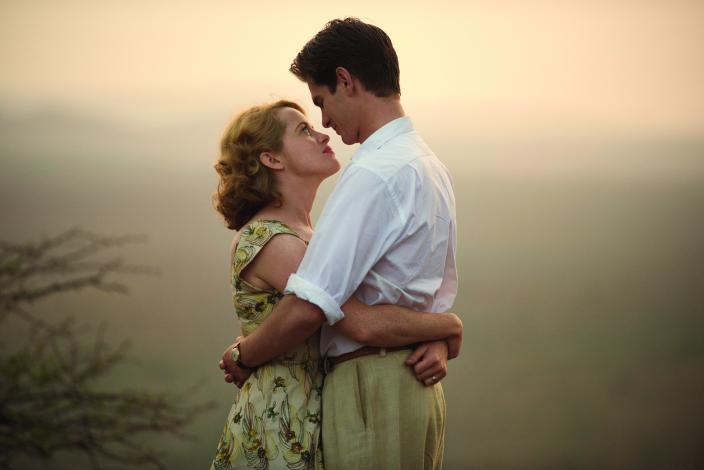
The Pitch: Choose life.
The Review: If you’re looking for a film to open Britain’s leading film festival then as soon as someone offers you more British acting talent than a bonnet full of Jane Austen adaptations, most of them with finely honed RP accents and with an opening scene culminating in a cricket ball smashing a tea cup, then you’d probably bite their hand off. You’d probably also expect that a hard-working British film would be stiff upper lips, struggles against adversity and as grim as Ken Loach’s kitchen sink. Breathe serves up two out of three in a reasonable debut for Andy Serkis, but suffers from never quite being sure what it wants to be.
With a list of British talent longer than your arm, some in blink-and-miss roles (Diana Rigg’s screen credit may get more time than she does), Serkis has certainly assembled a talented acting roster, but the only two who really have the opportunity to do more than reading their lines are Andrew Garfield as polio patient Robin Cavendish and Claire Foy as his supportive wife Diana. When stricken with the illness at a young age, Robin can’t face living a life staring at the hospital ceiling, but Diana takes on the medical profession and enlists the help of a creative friend or two to give Robin a new lease of life.
There’s plenty that works here, with Garfield and Foy putting in strong performances. The script also brings out British qualities you wouldn’t necessarily expect from such a film, with stoicism and determination supplemented by inventiveness and eccentricity. For large parts this is less a grim slogfest, more a vibrant celebration of life and its possibilities, with a handful of satisfyingly off-kilter moments thrown in. While Robin gradually escapes the confines of his hospital bed, the depictions of those less fortunate give the opportunity for some bizarre, discomfiting images, particularly at a clinical hospital that thinks it’s cutting edge.
Serkis has worked on this in down time of his Jungle Book adaptation, and his direction style could be damned with faint praise as fine. He does get chance for a little special effects wizardry with Tom Hollander portraying both of Diana’s twin brothers, but other than that he’s content never to stray from the confines of a chocolate box lid picture, and the film is sometimes as sweet when it desperately needs more courage in its convictions. Society still hasn’t found equality for disabled people in many areas and films highlighting this struggle are as important as those exploring divides of gender, race and orientation but Breathe calls attention to human frailty and meaningful questions of existence without ever suggesting it truly wants to engage with them.
This is particularly noticeable in the final stretch, when questions of Robin’s right to life become flipped on their heads. The last act aims to engage the heart and squeeze the tear ducts when a more confident director would have tapped at your mind and soul as well. It’s a shame, for while Breathe should play well to anyone in the the middle-aged art house crowd who prefers their films with the rough edges sanded off, the material had the potential for a truly great British film and the aftertaste here is one of squandered opportunity. Hopefully as Serkis hones his craft, he’ll be willing to encourage a degree more boldness in his screenwriting collaborators.
Why see it in the cinema: Enjoy the view, from sweeping Kenyan vistas to the rolling English countryside, and see if you can hold back the tears at the end when your neighbour is struggling.
What about the rating? This one’s a 12A for infrequent bloody images, mainly when Robin is struggling in later life (although the old age make up Garfield’s sporting is perhaps more horrific).
My cinema experience: After two weeks of pre-festival screenings at the well-appointed BFI Southbank, this was the first trip the Odeon Leicester Square (and my first visit there since seeing Armageddon over twenty years ago). The uncomfortable leopard print seats and terrible viewing angle from the stalls didn’t convince me I’d missed much. That was all forgiven when director Serkis appeared to give the film a five minute intro.
The Score: 7/10
Wreckers: An Interview With Dictynna Hood
 You might recall an article I wrote last year about a film that had been made in my own village last year, called Wreckers, starring Claire Foy and Benedict Cumberbatch. I wrote a review, as well as a piece on how I was Sir Not-Appearing-In-This-Film, long before this blog was a glint in the milkman’s eye, but I also took the opportunity to conduct an interview with the writer and director, Dictynna Hood.
You might recall an article I wrote last year about a film that had been made in my own village last year, called Wreckers, starring Claire Foy and Benedict Cumberbatch. I wrote a review, as well as a piece on how I was Sir Not-Appearing-In-This-Film, long before this blog was a glint in the milkman’s eye, but I also took the opportunity to conduct an interview with the writer and director, Dictynna Hood.
The interview took place at a local tea shop, where we had some delightful tea and scones, and I recorded a forty minute interview on my iPhone, which came out surprisingly well. Typing it back now has been a strange experience – particularly listening to the clanking and bustling going on in the rest of the tea shop – and Dictynna was a very open and friendly interviewee for my first such attempt, for which I must say a big thank you. We covered a wide variety of topics, everything from the films of Michael Haneke to Doctor Who, but it’s the cinematic impact and benefits that I’m most interested in, so what’s here are my questions specifically around that subject, and the film in general.
The film is showing tonight and tomorrow night (24th / 25th April) at the Cambridge Arts Picturehouse, and tonight there will be an opportunity to ask Dictynna your own questions. Hopefully if you’re in the area you’ll be able to make it, and enjoy both the film and the Q & A as much as I did.
When you set out to make Wreckers, was the intention to get it into cinemas or was it just an extension of the short films you’d made previously?
I was definitely thinking of it for cinemas, knowing that we’re selling to the BBC and abroad it will also be mainly TV sales, but we definitely wanted the cinema release. Claire Foy is also very filmic; she has this quality that you can just watch her. She does a lot of watching, not speaking, in the film and I think holds the screen fantastically, which is one of the reasons it’s gone into the cinema. In the cinema, you can also see the subtlety of the performances more clearly, which gets lost a little on TV when you’re more focused on the plot.
What was it that decided you to set it in a village specifically? Was it more plot driven or was it about the film economics?
A little of both, really. It’s very contained, and while there’s a budgetary reason for that people have mentioned at Q & As that they saw that containment as a blessing. There were a lot of people who helped with the production of the film who’ve ended up being cut; nothing to do with them or their performance, but that was all to do with keeping that contained feeling. The village in the film isn’t a literal reflection of the real village itself, or the village I grew up in, but it’s important that there’s that small space with a very large area around it.
I had a fascination with the Fens for a long time; I also had a look at the West Country, and took a lot of pictures, but it somehow didn’t feel right. I had a book of Fenland stories which was inspirational. I was looking for a village that wasn’t too twee or precious. A friend suggested looking in the Isleham area, and when I went to the village I found the church open and the layout of the village was immediately appealing. I’d also looked at Norfolk, but the extreme landscape on the Fens was just so appealing.
I understand you studied in Cambridge; was that where the love affair with the area came from originally?
No, I think it actually came from the book of stories originally, but it wasn’t something that it particularly occurred from my studying. I’d been on a biking holiday with my sister on the Fens when I was younger, but it didn’t capture me then, only later. I’d still love to do more filming in the area in the future, possibly getting on the water, or exploring the farming and the legends. I do think it’s one of the most extreme landscapes in the UK, and it gets away from all the murder mystery and period drama feel that you normally associate with the countryside.
Although I live in the village, I wasn’t aware of who you had in the film until after you’d finished filming. How did you put a cast like that together?
We cast them because we thought they were a cracking cast; as it turns out, everyone else seems to have thought that as well! They were fantastic, and obviously that has helped the film enormously. Their profile has increased since we filmed, and we were very lucky to get them all, especially given how especially Benedict’s profile has soared since. He makes David’s character very ambiguous, with a more straightforward performance the film would have taken a very different turn, and potentially been less interesting for it.
Reading interviews with him, he seems to be in it very much for the craft rather than the attention. How did he come across when filming?
My impression is that he loves to work, and that’s why he did the film, as he had a gap in his schedule. I read in one of his interviews that he wanted to follow the James McAvoy path, mixing blockbusters with films like this, but his schedule actually made finishing the film rather complicated.
When did you actually film? Was it a couple of years ago?
It was 2009, and it’s actually turned out to be a real help that it’s taken a while to put together, in terms of the profile of the cast and where they are now, but at the time it didn’t it didn’t feel like that, it felt like, “why can’t we just finish this bloody thing!”
I need to be careful, I’m technically a PG blog!
But no, everything about it felt wonderful in the end, for such a small production.
How do you go about getting a film into something like the London Film Festival [the film played at LFF in 2011]? Is it a fairly lengthy, tortuous process?
When we showed it to our cast and crew on a big screen for the first time we realised the film had a real pull in the cinema. Then we hosted a couple of screenings for industry folks and got Artificial Eye our distributor on board at that point which no doubt helped. We invited one of the programmers for the London Film Festival to an industry screening, it’s certainly better if a programmer can see your film big screen.
Do you think that British film is becoming confined to the festivals? It seems harder to get distribution for British films these days.
We had very realistic expectations for our film and it’s already gone beyond those expectations. I saw a lot of bold films at the London Film Festival which probably won’t get a release, but I’m not sure what the answer is; maybe more the French style of distribution. There’s a lot more film clubs in villages these days, which does open up more opportunities for folks to see films on the big screen. From a filmmaker’s perspective it does help enormously if you can cast people more recognisable to a wider audience, but it’s a shame if you have to do that at all times.
Has Wreckers turned out pretty much how you imagined it?
We realised on day three that we couldn’t shoot our storyboard, so we had to work out quickly how to capture the feeling we were after, happily we’d had a lot of discussion during pre-production about the grammar and the atmosphere of the film and how to maintain that even if shooting not exactly as planned. Even if you’re Hitchcock or Kubrick, as soon as you cast it the film becomes something different, as actors embody the characters and make them their own. The key as a director is to hold on to the core ideas and the core feeling of the film and to create around that. It’s was Annemarie’s [Lean-Vercoe,director of photography] first or second feature, and I couldn’t have done it without her, but all of the crew were magnificent.
What’s next for you, now that Wreckers has been a success and gotten into cinemas?
I’m exploring what to do next; we’ve got a story about a big family gathering where the parents are ageing hippies, and we’ve got a wonderfully twisted rom-com. I want to get on and direct more, but you have to make sure that the script is a match, and I guess the joy of writing is that you know your script is a match! [laughs]
Dictynna Hood, thank you very much.
Wreckers is also available on DVD now from all good stockists.
Review: Wreckers
 The Pitch: The true village people.
The Pitch: The true village people.
The Review: If you were attempting to take a snapshot of British life from the output of our film industry, you might think that we’re stuck somewhere between a sumptuous costume drama, a brutal gangland thriller or a Richard Curtis comedy. Unless you’re Mr Darcy, Danny Dyer or Dawn French, you may not find these to be the most realistic or relatable portrayals of the core of British society. As for an understanding of village life, The Archers or Emmerdale are the closest that popular culture has come to understanding what makes a village tick, but now writer / director D R Hood has given us her insight into the lives of villagers and the secrets hidden behind the calm façade of life in the country.
Dawn and David (Claire Foy and Benedict Cumberbatch) are attempting to make a life for themselves in the country, in the village where David grew up. It seems the perfect couple have found the perfect home, but the arrival on the scene of David’s brother Nick (Shaun Evans) opens up a few closets with skeletons in, and starts to sow a small seed of doubt in Dawn’s mind. Having moved back to the village to start a family, Dawn begins to wonder if David is really the man she thought he was, especially as previously unknown details about the brothers’ childhood come to light. As Dawn finds herself drawn closer to Nick, their relationships become increasingly strained and Dawn finds herself faced with difficult decisions.
Wreckers is, first and foremost, an actor’s film, but it never descends to the level of melodrama, the performances all marked out in subtle shades rather than broad strokes. Claire Foy is at the heart of the film, and she captures perfectly the sense of conflict as she struggles to come to terms with what she’s learning. Opposite her, Benedict Cumberbatch is full of simmering tension and later controlled rage, hidden so far beneath the surface that it would be undetectable in a lesser actor. Shaun Evans completes the central trio, and while his performance isn’t quite the match for subtlety of his co-stars, his in-your-face manner a suitable counterpoint to the more understated performances of the two leads.
The other star of Wreckers is the scenery, the East Anglian countryside being used very effectively not only to emphasise the increasing isolation of the characters but also to give contrast to the lives they’re leading. There’s an almost dream-like quality to some of the photography, and the combination of this and the score from Andrew Lovett help to emphasise the placid nature of the surroundings, which only serves to give more edge to the unfolding drama. The story itself is a little linear, but that doesn’t detract from the overall effect, and there’s a pleasing sense of ambiguity around the ending. While Wreckers might capture the scenery and the atmosphere of village life, its moral dilemmas are somewhat more universal, but it’s worth catching for the combination of great actors working close to the top of their game in quintessentially English settings, and is a refreshingly different slant on British life without the need for British stereotypes.
Why see it at the cinema: The combination of the beautiful scenery and the intimate drama will work best on the big screen; the countryside scenes are almost hypnotic at times but the camera gets in close to the actors, and the cinema screen will capture every intimate glance and nuanced gesture.
The Score: 8/10
Wreckers: A Local Film For Local People

Ever wanted to be famous? Judging by the proliferation of TV talent shows clogging our screens, there’s quite a number of people who’d like to be discovered, for singing or dancing or even dog-wrangling, and become just famous enough that they can perpetuate that by being sent to the land of the convicts to eat various marsupial genitalia while being mocked by slightly receding Geordies. I’m not sure I’ve ever had that compulsion, but it was put to the test a couple of years ago when the village where I now live became the setting for a feature film.
While I’ve been a lifelong fan of film, and that love has grown to almost obsessive proportions in the past few years, it’s what’s on the screen that’s always interested me. I’ve certainly come to question the artistic decisions of a few writers and directors over the years, but I’m not sure the creative urge has ever burned that brightly within me, nor for that matter have I ever been a fan of the spotlight. Even at school, I was quite content to take on the backstage roles and to allow others to get their lights out from under bushels; and although one of my other hobbies has always been singing, I’ve always been more comfortable taking a role in the choir rather than out front singing solos. But moving to the village allowed me to take on another role, that of choir master of the choir at the village church, and it’s ideal in the sense that the back of your head gets more attention from the congregation or audience than your face ever does. Few roles offer such power and such anonymity in the realm of artistic endeavour.
But it was through the church music that I first came into contact with an actual film in production, back when The Movie Evangelist was just a glint in the milkman’s eye. I had an e-mail from the writer and director of the film, a lady by the name of Dictynna Hood, and she’d been scouting for a village to use in her first full-length feature film. As there were potentially scenes in the church and involving two of the characters singing in the choir, I was involved in discussions about the possibility of using the choir on film. No sooner had my visions begun of seeing my name in lights – admittedly very tiny ones at the end of some credits – than the decision was made to go with a choir more suitable to the filming process: in other words much better singers than us and people who could be subjected to the vagaries of filming schedules more easily.
When the actual filming happened, it all pretty much passed me by. I was aware that something was happening, by the fact that the village pub had suddenly developed blacked out windows, but I can recall neither seeing a film star or anyone that looked like they might be a director of photography, a key grip or even a best boy. Consequently I thought little more about it until earlier this year, word came through to the village that the film was finally nearing completion, after a duration by no means uncommon in the world of movies, and that it was hoped to gain a cinema release later in the year. I also discovered at this point that the film had actual proper famous people in it, including Claire Foy and Benedict Cumberbatch.
How had I missed that? Had it been kept secret to avoid hordes of screaming Cumberbatchites swamping the filming? Admittedly this was pre-Sherlock, before he became a household name (and any household, surely, would be thrilled to have such a fantastic name, packed full of rich consonants and exciting syllables), but he’d still been in Atonement, The Other Boleyn Girl and Starter For 10 when he came filming, and I’m not saying the village isn’t exciting, but I’ve known people who’ll come out for the opening of a bottle of pop, never mind somebody famous. Or maybe I was just off in the cinema, taking in big screen dramas while a smaller one was unfolding right on my own doorstep. But when the news came in that there’d be a screening in the village of the film before it went to cinemas, it felt like too good an opportunity to pass up.
Which is how I found myself conducting my first actual interview, in a quaint little tea room in the next village, on a cold afternoon in November. I had engineered opportunities to talk to two other directors last year, one of whom was Mark Cousins, whose 15 part epic The Story Of Film sits unwatched on my Sky+ box as we speak, desperately waiting for me to find time to watch it. So the fact that this was actually coming to me seemed too good an opportunity to miss, and Dictynna and I enjoyed a cream tea, while talking about everything from the films of Michael Haneke to whether Benedict would make a good Doctor Who. (I’m still so busy that a month later, I still haven’t typed it up, and I’m even sat writing this on my iPhone on a train to London. But at least it’s in the can. Or the voice memos. Or something.)
The screening that followed that evening was a real triumph for the power of cinema to bring people together, and marked the first time that I’ve attended an advanced screening where the director brought crisps and home-made cakes for the audience. (I genuinely hope it’s not the last time.) Sadly, there was nowhere in the village with suitable facilities to hold the screening, but the nearest town has a hall where they hold a monthly cinema club with a projector and a big screen. Which I also hadn’t heard of. But that evening, over 100 villagers and a few curious members of the film club packed the hall to see an advanced screening of Wreckers.
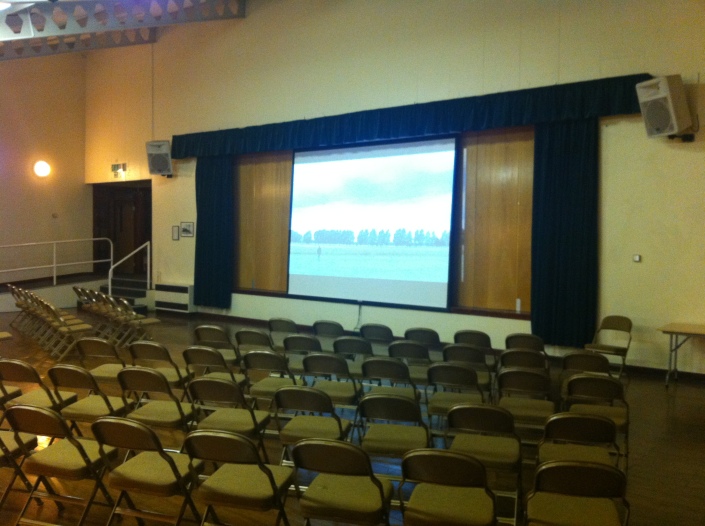
It took me around ten minutes to actually be able to focus on the film itself. I’ve seen a few films where I’ve known the landmarks, and it does give a slightly eerie sense when watching the film; if you’ve ever seen London landmarks featured in a film and walked those streets, you’ll have some understanding of the principle. I also saw another British film recently, Weekend, which was filmed on the streets of Nottingham, and which caused me to have a few moments of recognition which took me out of the film slightly, having worked there for two years. But this is nothing to the effect of watching a film made on the very small streets of a village that’s been your home for the past four years, not least because film geography and actual geography can be two different things.
Take, for example, the church. There’s a number of scenes set both inside and outside the church, and on two occasions characters have a conversation outside the porch, then turn and walk off through the trees to their houses. Here’s a shot of the porch itself:
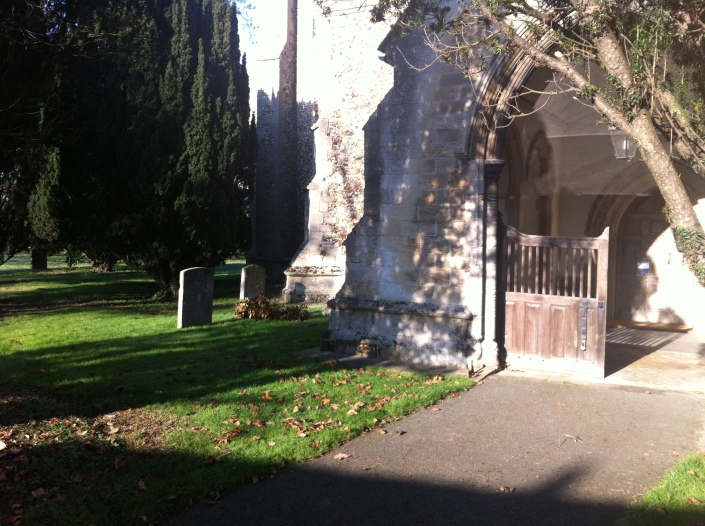
There are trees to the left of the porch, which the characters wander through on their way home. And here’s a shot of exactly what’s through those trees:
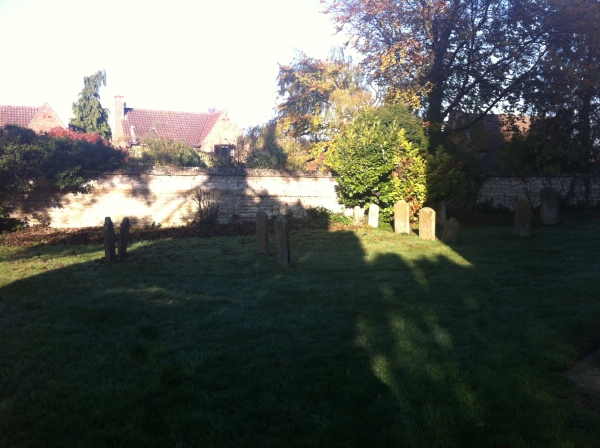
Yes, through the trees is not a leafy, tree-lined path, but a walled churchyard from which the only escape is the gate opposite the porch, in completely the other direction. The temptation to stand up and to shout at the screen “WHERE ARE YOU GOING?!?!” was one that I barely resisted. Similarly, walking to your house through fields which are not connected, or walking to the school which appears to be in another village entirely in real life, were all disconcerting reminders that what we see on screen is a construct, and only as real as our imaginations, a point which Dictynna attempted to remind the audience of before the film.
The reaction afterwards was mixed, although I firmly believe that was the audience rather than the film. Every film needs to find its own audience, and Wreckers rather had one thrust upon it rather than naturally finding its own, but it was at least a lovely and heartfelt gesture to reward the patience of those that gave their time to its making. There is, I’m sure, some irony in the difference between the fictional village and its hotbed of infidelity and secrets, and the warm, open welcome which the actual villagers provided, but at least that generosity has been repaid in kind.
And as for me? Anyone who’s read this blog before may recall that I’ve already had one inanimate object I’d come into contact with become more famous than me; I have a music stand in church which I use when conducting, and that stand was used by the visiting choir’s director. It is in the film for around two seconds by my estimation, but it’s there on screen. If you look really closely.
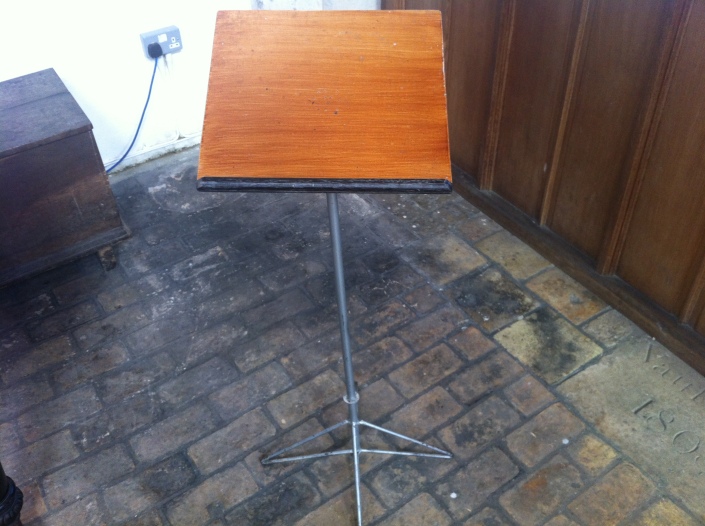
So now, even my own music stand is more famous than I am. On reflection, It’s a good job I don’t like the taste of kangaroo testicles.